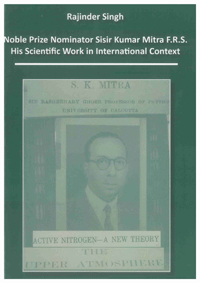
Shop : Details
Shop
Details
12,90 €ISBN 978-3-8440-2654-2Softcover194 pages28 figures269 g21 x 14,8 cmEnglishReference book
April 2014
Rajinder Singh
Noble Prize Nominator Sisir Kumar Mitra F.R.S.
His Scientific Work in International Context
The Physics Nobel Prize nominator Sisir Kumar Mitra F.R.S. (1890-1963) initiated the ionospheric science in Calcutta, India. A crater on the moon, and various places and institutions in Calcutta are named after him. He was associated with renowned scientific institutions, for instance, the Asiatic society of Bengal, Indian Association for the Cultivation of Sciences, and the University of Calcutta. He occupied authoritative positions in peer scientific bodies, such as, the Indian National Science Academy, Indian Science Congress Association. S.K. Mitra trained a galaxy of young scientists, who influenced the development of atmospheric, radio- and electronic science in India. One of them, Mrinal Kumar Mitra (along with Roger Clifton Jennison), discovered the first double radio galaxy.
S.K. Mitra began research on optics under C.V. Raman, who in 1930 won the Physics Nobel Prize “for his work on light scattering and the discovery of the effect named after him.” To explain the diffraction pattern in heliometers, Mitra developed a new theory. Mitra and his associates studied the atmosphere (mainly ionosphere) under varying conditions. They experimentally discovered the D-layer, interpreted the cause of the E-layer, clarified the Appleton magnetic control anomaly in F2-layer, and showed the effect of meteoric showers on the E-layer.
To explain the night sky luminescence and afterglow phenomena, Mitra gave “The ionic theory”, which was later renamed as “The metastable atomic theory.” The former was published as: “Active nitrogen – A new theory.” Mitra’s better known work is the book: “The upper atmosphere”, which deals with atmospheric research until 1952. For his scientific achievements, he was elected as a Fellow of the Royal Society London. According the available documents of the Swedish Academy of Science, until 1955, Mitra was the only Indian physicist to be invited thrice to nominate candidates for the Nobel Prize.
In the present work, it has been attempted to analyse Mitra’s scientific achievements in an international context; and to discover - How was his work seen by the scientific community abroad? The social historians of science are curious to know the origin of scientific ideas. In the case of Mitra, these ideas have been able to be traced. Nobel Prizes and the Fellowship of the Royal Society of London are of interest for scientists as well as general public. Documents on S.K. Mitra were obtained from the Nobel Committee and the Royal Society of London. Results and interpretations of their analysis are given.
S.K. Mitra began research on optics under C.V. Raman, who in 1930 won the Physics Nobel Prize “for his work on light scattering and the discovery of the effect named after him.” To explain the diffraction pattern in heliometers, Mitra developed a new theory. Mitra and his associates studied the atmosphere (mainly ionosphere) under varying conditions. They experimentally discovered the D-layer, interpreted the cause of the E-layer, clarified the Appleton magnetic control anomaly in F2-layer, and showed the effect of meteoric showers on the E-layer.
To explain the night sky luminescence and afterglow phenomena, Mitra gave “The ionic theory”, which was later renamed as “The metastable atomic theory.” The former was published as: “Active nitrogen – A new theory.” Mitra’s better known work is the book: “The upper atmosphere”, which deals with atmospheric research until 1952. For his scientific achievements, he was elected as a Fellow of the Royal Society London. According the available documents of the Swedish Academy of Science, until 1955, Mitra was the only Indian physicist to be invited thrice to nominate candidates for the Nobel Prize.
In the present work, it has been attempted to analyse Mitra’s scientific achievements in an international context; and to discover - How was his work seen by the scientific community abroad? The social historians of science are curious to know the origin of scientific ideas. In the case of Mitra, these ideas have been able to be traced. Nobel Prizes and the Fellowship of the Royal Society of London are of interest for scientists as well as general public. Documents on S.K. Mitra were obtained from the Nobel Committee and the Royal Society of London. Results and interpretations of their analysis are given.
Keywords: Sisir Kumar Mitra; atmosphere; ionosphere; radiophysics; Indian scientists; Calcutta; Nobel-prize; ozone; active-nitrogen; afterglow; meteor; Raman; Saha; Bose; Mitra
Available online documents for this title
DOI 10.2370/9783844026542
You need Adobe Reader, to view these files. Here you will find a little help and information for downloading the PDF files.
Please note that the online documents cannot be printed or edited.
Please also see further information at: Help and Information.
Please also see further information at: Help and Information.
| Document |  | Abstract | ||
| Type |  | |||
| Costs |  | free | ||
| Action |  | Download the file | ||
| Document |  | Document | ||
| Type |  | |||
| Costs |  | 9,67 € | ||
| Action |  | Purchase in obligation and download the file | ||
| Document |  | Table of contents | ||
| Type |  | |||
| Costs |  | free | ||
| Action |  | Download the file | ||
User settings for registered online customers (online documents)
You can change your address details here and access documents you have already ordered.
User
Not logged in
Export of bibliographic data
Shaker Verlag GmbH
Am Langen Graben 15a
52353 Düren
Germany
Am Langen Graben 15a
52353 Düren
Germany
Mon. - Thurs. 8:00 a.m. to 4:00 p.m.
Fri. 8:00 a.m. to 3:00 p.m.
Fri. 8:00 a.m. to 3:00 p.m.
Contact us. We will be happy to help you.



